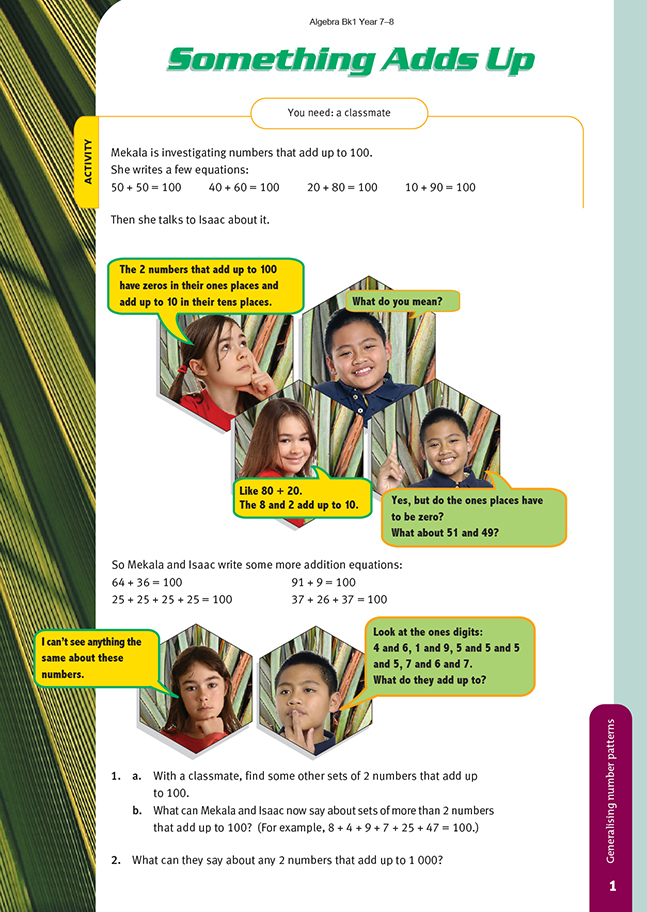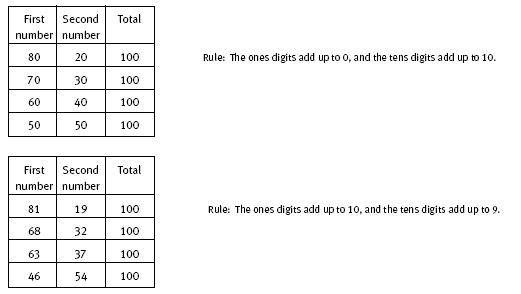This is a level 2 algebra strand link activity from the Figure It Out series.
A PDF of the student activity is included.
Click on the image to enlarge it. Click again to close. Download PDF (314 KB)
generalise the addition pattern for numbers that add to 100
FIO, Link, Algebra, Book One, Something Adds Up, page 1
classmate
This activity will help students to increase their understanding of number structure, in particular of decimal (or base 10) representation.
In question 1, the students should focus separately on the digits in the ones place and the digits in the tens place to help them identify the links between any 2 numbers that add up to 100.
The students may find it helpful to complete tables like the ones below. To do this, they must add the digits in the ones place and then the digits in the tens place. Encourage them to write a rule for the ones and the tens digits in each table.
In question 1b, as in the 2-number sums making 100, the students need to focus on the sums of the digits in the ones place and then on the sums of the digits in the tens place. Tables like the one below can help the students to see patterns that lead to the rules shown alongside the table.
The students should test their rules by making up different sets of numbers. They also need to be sure that they have covered every possible rule. For example, an argument to show that in the 3-number case there are exactly three possible rules might go like this: “We know that the ones digits have to add up to a multiple
of 10. With 3 numbers, the biggest number we could get by adding up the ones digits would be 27 (when each ones digit was 9), so the only multiples of 10 we can get by adding up the ones digits will be 0, 10, and 20 (we can’t reach 30 or any of those above).”
Encourage them to predict rules when 4 numbers add up to 100, then when 5 numbers do, and so on. Each prediction needs to be tested to ensure the rule is sensible. For example, they could ask: “Is it always true that the number of possible rules is equal to the number of numbers being added?”
In question 2, the students should explore possibilities. If necessary, suggest that they use a table format as above to help with their explorations. They will find it helpful to work systematically with 2 numbers in cases where the digits in the ones place add up to 0, then with 2 numbers where the digits in the ones place add up to 10. Those students who are quick to see the rules might then explore what happens when 3 or
even 4 numbers add up to 1 000.
Answers to Activity
1. a. Sets will vary, but in each pair, the ones digits will add up to either 0 or 10, that is, the possible pairs of ones digits are 0 and 0, 1 and 9, 2 and 8, 3 and 7, 4 and 6, or 5 and 5. Note that, for every pair of numbers except those where the ones digits are both 0, the tens digits must add up to 9 (because you are adding another 10
from the ones digits).
b. Possible answers include:
The ones digits must add up to a multiple of 10, either 0, 10, 20, 30, 40, 50, 60, 70, 80, 90, or 100. If the ones digits add up to 0, the tens digits add up to 10; if the ones digits add up to 10, the tens digits add up to 9; if the ones digits add up to 20, the tens digits add up to 8; and so on.
2. The ones places must add up to 0 or 10. If the ones places add up to 0, the hundreds and tens places must add up to 100, for example, 630 + 370.
If the ones places add up to 10, the hundreds and tens places must add up to 99, for example, 286 + 714.


